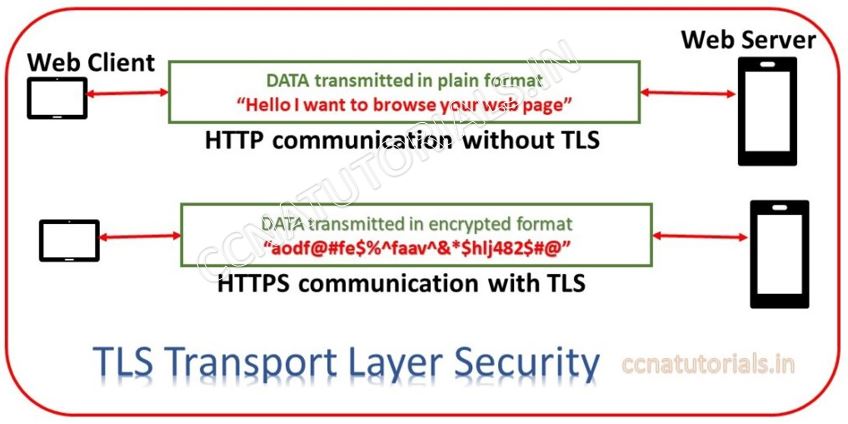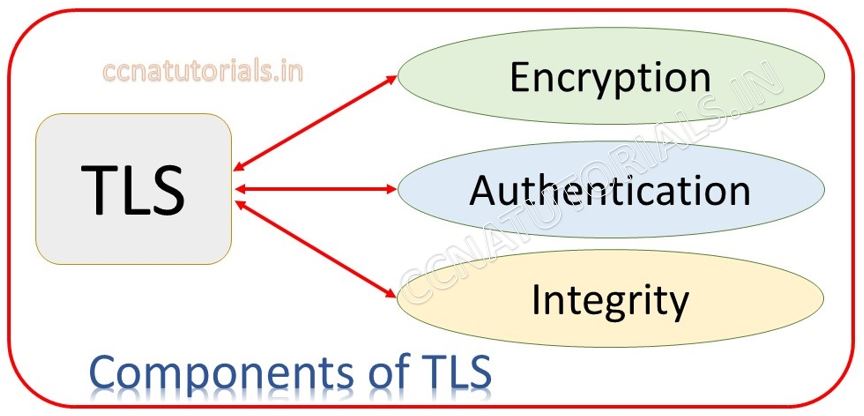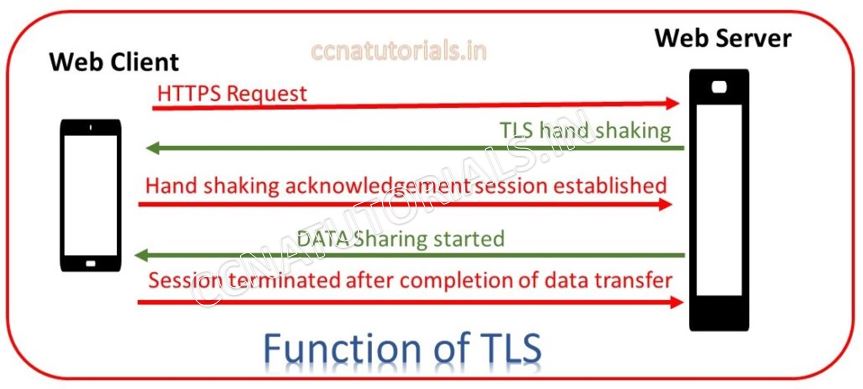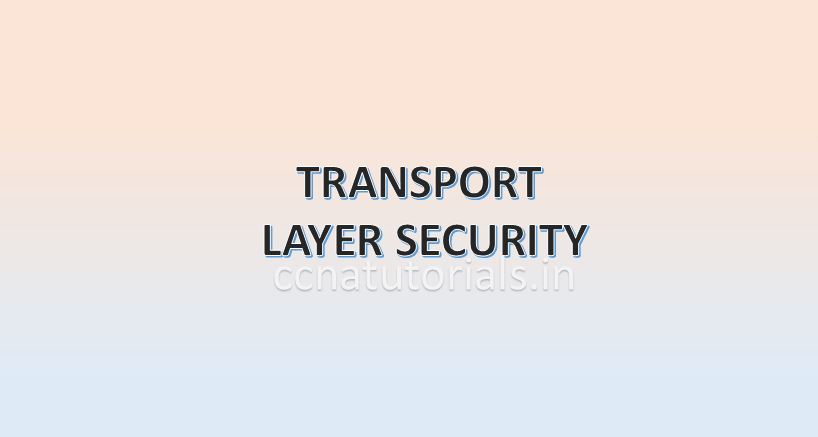In this article I describe the TLS Transport Layer Security in computer network for CCNA exam. TLS Transport Layer Security is related to application layer of TCP/IP Suite model. The TLS Transport Layer Security Protocol provide security to the data of web server on the computer network . TLS Transport Layer Security Protocol provide an additional layer of security when you browse any website on internet.
Web browser used the TLS Transport Layer Security when loading a website. TLS works for data and voice security between different devices over the internet. Routing and Routed Protocols provides the connectivity between different networks for data packets flow from one network to another network. A standard routing table is maintained by the routers for data packet flow between different networks.
Before going to learn about TLS Transport Layer Security we need to remember the OSI suite and TCP/IP suite model. There are many manufacturer of computer machine in the market. Initially when computers became single user public computer. The computers communicate with only same brand machines. It happens because there was no any fix standard for data transfer between different devices. It is very difficult to make communication with each other when the hardware are of different brands or company. In this article I describe the some basic part of OSI reference layer and TCP/IP Suite model basic concepts in networking with the TLS Transport Layer Security.
OSI reference model basic concepts
OSI reference model in computer network followed by various vendors to overcome the compatibility problem. After implementation of OSI reference model in computer network, equality maintains by all manufacturer. In 1970 the Open Systems Interconnection (OSI) reference model was created by the International Organization for Standardization (ISO). The OSI model was meant to create inter-operable network with different manufactured devices. In this article I describe some layered approach of TCP/IP Suite model basic concepts in computer network. Before understanding the TCP/IP Suite model basic concepts it is necessary to know about the 7 layers of OSI reference model because the basic work of each layer is described in the OSI reference model. You can read the full article related to OSI reference model in computer networking here.
Importance of OSI reference model for TLS Transport Layer Security
Before going to know about the TLS Transport Layer Security. It is necessary to know the function of application layer in OSI model and TCP/IP model. Initially not only hardware but software also not supported for work the different computer brand. It became very difficult for all computer users to working without implementation of OSI reference model in computer network. It is necessary then to make some common protocols for all vendors of computer. Before implementation of OSI reference model in computer network, all vendors implements their own protocols on computer hardware and software.
In networking OSI reference model became helpful. OSI reference model describes the flow of data between nodes in any network. Data from one computer application to another computer application transfer by following some common protocols. The OSI reference layer also become beneficial for troubleshooting the network problems. TCP/IP and Cisco three layered hierarchical model of Cisco became more helpful alongside the OSI reference model.
The Layered Approach in computer network for TLS Transport Layer Security
The Layered approach was the best way to make equality for all computer devices. Layers are not physical but following some protocols. Protocols are for connectivity, connections, data transfer and more. All manufacturer begin to follow the layered approach for OSI reference model in computer network. The OSI reference model change in TCP/IP reference model and later on Cisco three layered hierarchical model. OSI layer architecture have 7 layers. TCP/IP reference model convert these 7 layers into only four layers. After that Cisco three layered hierarchical model converts these 7 layers into three layers. Some layers combined to work in a single layer.
OSI is acronym for open system interconnection. The OSI is a logical reference OSI reference model in computer network. OSI model helps for data flow between different devices and operating systems. All manufacturer used their own architecture before invention of OSI reference model. It was very difficult to establish data communication between different devices. To overcome this problem international organization for standardization (ISO) created the open systems interconnection (OSI) reference model. OSI reference model make data flow possible between different operating system, devices and hardware. Later the OSI model adopted by Cisco as Cisco three layered hierarchical model.
Structure of OSI reference model related to TLS Transport Layer Security
OSI reference model in computer network consist of 7 layers. These 7 layers further divided into two groups. First 3 layers works for application communication and remaining 4 layers works for data flow. Application, presentation and session layers define the application communication. Transport, network, data link and physical layers define the data flow. Networking protocols works only on last four layers.
TCP/IP Suite model basic concepts for TLS Transport Layer Security
TCP/IP is acronym for Transmission Control Protocol/Internet Protocol (TCP/IP suite model). In this section of the article I describe about TCP/IP suite model basic concepts in detail. TCP/IP suite model is a reference model like OSI layers. Instead of 7 layers of OSI reference model. TCP/IP suite model consist only four layer. All seven layers are merged into four layers only. TCP/IP suite model was designed and implemented by Department of Defence (DoD). TCP/IP developed to preserve data integrity. The main purpose to develop the TCP/IP is to provide security in the network. A lots of protocols works on each layer to provide a secure network.
It is necessary to understood the protocols used in TCP/IP Suite model basic concepts. IP addressing play an important role in TCP/IP Suite model basic concepts. By using the IP address and subnet masking broadcast domain breaks. It will improve the performance of the network. Breaking broadcast domain increase the data flow speed. Here IP stands for IPV4 only. We ignore the IPV6 for some time in this article. It will make it easy to understand the TCP/IP Suite model basic concepts.
A snap of TCP/IP Suite model basic concepts
In the decade of 1970’s TCP/IP suite model developed by DoD. In the initial stage TCP/IP suite model divided into two segments TCP and IP. Later its name registered with combined name of TCP and IP like TCP/IP model. ARPA, the Advanced Research Projects Agency of DoD officially authorised to use TCP/IP suite model. TCP/IP model was working well so it was adopted by many organisations. In today scenario it is mostly using reference model for networking. Internet is the best example of using TCP/IP.
Process or Application layer of DoD model in TCP/IP Suite model
This is the first layer of TCP/IP of DoD model. It is combination of top three layers of OSI reference model. The functions of Application layer, presentation layer and session layer in OSI model works in single layer process layer. This layer supports the point to point communication and controls the user interface. The data encryption and decryption also done at this layer. Example of some protocols functions at this layer are TLS Transport Layer Security, FTP, LPD, TFTP, SMTP.
Transport layer of DoD model in TCP/IP Suite model
Transport layer of TCP/IP is same as the Transport layer of OSI reference model. It supports the TCP and UDP protocol. This protocol converts the main data segment into packets and transport to the internet layer. The responsibility of Transport layer is to combine the segments and built the data. The data should be reconstruct in its real form. Transport layer is also responsible for creating end-to-end communication between sender and receiver. This layer ensure the delivery of segment in sequence at the receiving device. This property maintains the data integrity.
Internet layer of DoD model in TCP/IP Suite model
Internet layer of TCP/IP is similar to the network layer of OSI reference model. Routing protocols functions on Internet layer of TCP/IP model. Addressing and filtering of packets is main responsibility of Internet layer of TCP/IP model. This layer provides the transmission of packet in the whole network. Some example of protocols functions on internet layer are ICMP, ARP and IP.
Link layer of DoD model in TCP/IP Suite model
Link layer is the least layer of TCP/IP. Basically link layer is combination of data link and physical layer of OSI reference model. Link layer is also known as Network Access layer. It works on MAC address based data transmission. Link layer handles the frame and bits. It receive the bits and constructs frame from merging bits in a sequence. In case of any bit is missing this layer request to re transmit the bits. Ethernet, FDDI, WAP etc functions on this layer. There is no any preset specification for link layer. Link layer functions on any type of existing media.
TLS Transport Layer Security explained in brief
TLS Transport Layer Security is a multilayer layer protocol. The TLS works on session layer or OSI model and Application layer of TCP model. TLS Transport Layer Security is a security protocol. TLS used for data security on internet. The TLS provides secure web communication over the internet. TLS encrypt the data transferred between web applications and servers. Web browser used the TLS Transport Layer Security when loading a website. TLS works for data and voice over the internet. Email, SMS message and voice are commonly encrypted by using TLS Transport Layer Security. The TLS protocol was published in 1999 and designed by IETF (Internet Engineering Task Force). HTTPS encrypted the data by using TLS protocol.

TLS encryption protects the website data from hackers. In today scenario mostly websites use HTTPS security to keep the data safe. Online transaction fraud also reduces by using TLS for HTTPS data encryption.
TLS (Transport Layer Security) and SSL (Secure Socket Layer)
TLS is advance version of SSL. Function of both protocols is providing encryption data over the internet. TLS version 1.0 developed from the SSL version 3.0. SSL Secure Socket Layer developed by Netscape. Name of SSL version 3.0 changed to TLS on publication. TLS is not belonging more to Netscape; TLS developed by IETF. In today scenario both TLS and SSL used to provide encryption data transferred over the internet. SSL and TLS are not compatible with each other. TLS designed such as to support the Old SSL versions from 1999.
Function of TLS Transport Layer Security.
TLS is a cryptographic protocol use for end-to-end communications security over the internet. HTTP is a plain protocol use to access the web application over internet. HTTP send and receive the data in plain format. The data transferred by using HTTP protocol may be hacked so it is not secure. To overcome this problem HTTPS protocol developed. HTTPS protocol is secure version of HTTP protocol for providing feature to access web application over internet.

The main difference is that HTTPS send and receive the data in encrypted format. The data is meaning less during transmit from sender to receiver. HTTPS use TLS for encryption the data. Sometime SSL also used for encryption data over the internet. We can say access of web application by using HTTPS protocol is implementation of TLS Transport Layer Security. TLS is combination of Encryption, Authentication, and Integrity.

Encryption provides security to data from hackers or unauthorised users. Authentication ensures the data communication done between real users. Integrity make the data real and valuable, fake data is identifies by its integrity.
Working of TLS Transport Layer Security
Initially the user send request to web server on HTTPS protocol. TLS installed in the webserver response the request and make TLS handshake. The TLS handshake protocol provides authentication between web client and server before any data is transmit. TLS handshake create secure connections between the user and web server. The connection creates by defining shared encryption keys.

The handshake makes sure that the user is an authorized person, not a machine. Public and private keys generally used for encryption and decryption of data during handshaking using TLS. After handshaking the data transmission starts between client and server. Session remains established between client and server till completion of data transmission. After successful data transmission the session closed, and handshaking is break between client and server.
In this article I describe the TLS Transport Layer Security in computer network for CCNA Exam. I hope you found this article helpful for any query or suggestions you may drop a comment below or contact us. Your suggestions are always welcome by us.






